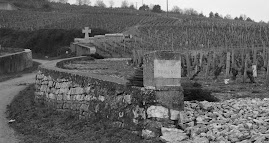My favorite area to navigate with our guests on our list is the two pages devoted to Pinot Noir. Granted there are plenty of wines that have dizzyingly steep prices on those pages. Like all winemaking areas of the world, certain wines and winemakers command exorbitant prices. Sometimes I get criticized for having some of these wines on the list. But I often say, (mostly to myself) “If you are going to have a French wine list, there are things that must be on it.” And those things are usually the most expensive. But there are some wonderful selections in Burgundy that are under $100.00 and some that are just a touch over that are well worth seeking out in a retail outlet.
Most of the wines I am going to mention are on the list at the restaurant I buy for, mainly because I know that they are available in Wisconsin and, most importantly, that they are spelled correctly. But if you take those examples and apply them to wines you may find in wine shops or on other wine lists, like the villages, vineyards and producers, you can find well made and reasonably priced wines.
There are three main quality levels in Burgundy: Village, Premier Cru and Grand Cru in ascending levels of pricyness. The village level wines are the ones that just list the name of the commune without a vineyard name. Now knowing what those are is the rub but if you take a:
· Maison Bouchard Père et Fils Meursault at $30.00
· Domaine Bouchard Père et Fils Meursault Premier Cru “Les Genevrières” at $130.00
· Domaine Bouchard Père et Fils “Corton-Charlemagne” at $230.00
Then the first is the village, the second is Premier Cru (or 1er) that lists the village and the vineyard, and the Grand Crus will be the ones that don’t list the village at all, just the vineyard, and command nosebleed prices. Note that the wines called “Maison” are the more inexpensive wines of the producer than the “Domaine” wines. Maison usually refers to wines made from grapes, juice or made wine that is purchased and bottled under the producer’s name. Domaine wines are made from grapes from vineyards the producer owns and bottles on their property, and are therefore more expensive.
In Burgundy Caveat Emptor or “let the buyer beware” is key. The commune of Vosne Romanee (pronounced vohn raw-ma-NAY) has some of the most expensive real estate in France with the Grand Crus of La Tâche and Romanée Conti commanding thousands of dollars – really. But a village level wine from there would not be worth the price of admittance. There are plenty of producers that make village level wines that ride on the coat tails of the Grand Crus that are in their commune. This commune is the most glaring example.
I have had success buying red burgundy at the village level from these villages:
Gevery-Chambertin
Chambolle-Musigny
Nuits-St.-Georges
Volnay &
Pommard.
Especially the wines from Volnay. The wine makers there have a reputation for making wine with tons of integrity. Low yields and biodynamic (kinda like organic with a lunar aspect) farming principles are common place here. And there are wines of splendid quality from all classifications. Producers to look for are Bouchard Père et Fils, Domaine de la Pousse d’ Or, Maison Louis Jadot and Olivier Leflaive.
Premier Cru wines that I think are splendid:
Chambolle-Musigny “La Combe D’Orveau” from Domaine Anne Gros
Her family has been making wine in Burgundy since 1951.
Nuits-St.-George “Les Cailles” from Bouchard Père et Fils
There are no Grand Crus in Nuits- St.- Georges and some of the top Premier Crus are totally worth seeking out like Les Cailles, Les Damodes, Clos de la Maréchale and Aux Champs Pedrix.
Volnay “Clos de la Bousse d’Or”, Santenay “Clos Tavannes” and Pommard “Les Jarollières” all from Domaine de la Pousse d’Or are all beautiful wines.
These wines are going to be more expensive than the village level wines but I don’t think any are going to be over $75.00 retail.
One more wine I NEED to mention. You can go out of Burgundy and find Pinot Noir in other AOC’s. One of note is Sancerre in the Loire Valley. I poured a Sancerre Rouge from Eric Louis “Les Celliers de la Pauline” at our recent Paris Chefs dinner. It was a huge hit AND it will probably cost less than $30.00. It is a fruitier style but has plenty of structure. Seek it out!
In Burgundy you will find the gamut in price and quality, more so than in most regions in France. But finding the best, which certainly doesn’t mean the most expensive, can be very rewarding.
There's nothing serious in mortality.
All is but toys; renown and grace is dead,
The wine of life is drawn, and the mere lees
Is left this vault to brag of.
William Shakespeare (1564-1616)
Macbeth, II. iii. (100)
Santé



